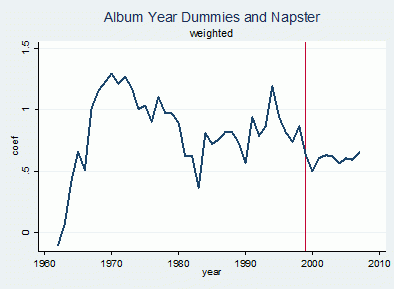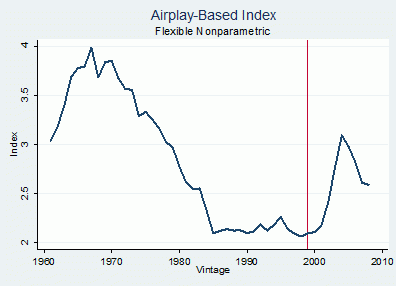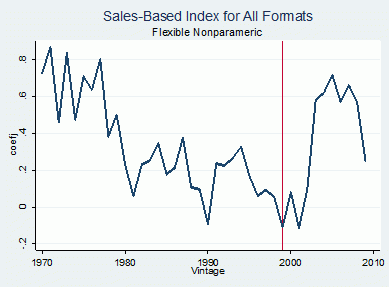A dozen years ago a program was created called Napster. It made it easy for ordinary people to download music from their friends and people they had never met. Despite the rock ‘n’ roll ideals of free music for everyone, it changed the music industry forever – some would say for the worse.
Since then, intellectual property rights have been substantially weakened. Unfettered stealing has caused revenues to the recorded music industry to tumble by roughly one third. While this reversal has prompted academic chin-scratching over its cause, most observers now agree that consumers’ ability to steal music undermines firms’ ability to sell it.1 The woes of the recorded music industry, along with fears of the movie, television, and book industries, have led many to advocate stronger legal protections for intellectual property, including private lawsuits, and threats of disconnection from internet service.
While the question of whether stealing undermines selling is of vital interest to the recorded music business, it is arguably not the only important question for evaluating the success of intellectual property rules. The purpose of copyright laws is to provide incentives for the creation of new works. Weakened intellectual property protections present a threat to consumers as well as producers. If producers cannot appropriate sufficient revenue to cover their costs, they may stop bringing new products to market, causing harm to consumers as well as producers. Keeping this in mind focuses attention on a different question. What has happened to the volume – and quality – of new works since Napster?
Three approaches to documenting quality
Documenting the volume of high-quality work is challenging, but in recent work I have developed three approaches to characterising the evolution of music quality over time. The first approach makes use of critics’ retrospective best lists, such as Rolling Stone’s list of the 500 best albums of all time.2 Inclusion of a work on such a list means that it has quality above some time-constant threshold. Each list can be transformed into an index showing the number of listed works originally released in each year. I have 88 such lists from Anglophone sources, together covering the period between 1960 and 2010. These lists’ associated indices can be combined statistically to produce an overall index of music quality. As Figure 1 shows, the index rises from 1960 to 1970, then falls, remaining low during the 1980s. The index rises during the first half of the 1990s, then falls in the second half. Following 2000, the decline stops, and the index is flat. The critic-based index provides no evidence of a decline in recorded music quality since Napster.
Figure 1
The second and third approaches make use of information on the service flow of recorded music, based on sales and radio airplay, by time and vintage.3 For example, I observe the share of music on US radio in 2008 that was originally released in 2008 and each preceding year. I observe the analogous vintage distribution for music aired in each year back to 2004. I also observe coarse data on music sales by year and vintage, so I observe the share of music sold in, say, 2010 that was originally released in 2010 and in each previous year. I observe analogous sales data back to 1970.
In any given year, shares vary across vintage for two reasons. First, music depreciates - music sells less, and is played less on the radio, as it gets older. Second, vintages may differ in their quality. If the quality of music had declined after 2000, then we would expect elevated use of older vintages after 2000, controlling for deprecation. Thus, if I can account for depreciation, the remaining variation in use by original vintage should reflect vintage quality. To this end, I regress the log share of music used in a year t from vintage v on a flexible set of age dummies (to account for depreciation), along with a flexible set of vintage dummies. The coefficients on vintage dummies show the evolution of vintage quality over time.
The results
Results are interesting. The airplay data allow me to infer vintage quality back to 1960 and exhibit the following pattern (in Figure 2) - quality rises from 1960 to 1970, then falls and remains flat from 1980 to about 1999, with a small bump up in the mid-1990s. After 2000, vintage quality rises sharply, reaching levels not seen since the 1970s. The sales data, which produce an index going only back to 1970, suggest a similar story - vintage quality declines from 1970 to 1980, is flat to 2000, then rises after 2000 (see Figure 3).
Two points are in order about these results. First, the three approaches, while independent of one another, produce broadly similar patterns from 1960-2000. Second, none of the three approaches shows a decline in quality following 2000; and two of them – based on actual music usage – show substantial increases.
Figure 2
Figure 3
These results are, at first blush, puzzling – how could the flow of high-quality music continue despite sharp reductions in firms’ ability to appropriate revenue? The puzzle’s resolution may lie in the observation that technological change has not only reduced effective demand; it has also reduced costs of bringing music to market. The costs of creation, promotion, and distribution have all been revolutionised by new information and communications technologies.
Conclusion
While the traditional purveyors of recorded music – the major record labels – have suffered since Napster, good music has continued to make its way to market. Independent labels account for a growing share of successful music, measured both by critical acclaim and sales. While many producers of recorded music have been made worse off by changes in technology, there is no evidence that the volume of high-quality music, or consumers, have suffered. Many caveats are in order, however. Chiefly, it is not clear whether the results extend to other content industries where creation remains quite expensive. But the results are a reminder that an evaluation of copyright policy should be cognisant of its effects on both producers and consumers.
References
Liebowitz, Stan J (2006), "File Sharing: Creative Destruction or Just Plain Destruction?”, Journal of Law and Economics, 49(1), 1-28.
Oberholzer‐Gee, Felix and Koleman Strumpf (2007), “The Effect of File Sharing on Record Sales: An Empirical Analysis”, Journal of Political Economy, 115(1):1–42.
Rob, Rafael and Joel Waldfogel (2006), “Piracy on the High C’s: Music Downloading, Sales Displacement, and Social Welfare in a Sample of College Students”, Journal of Law & Economics, 49(1):29-62.
Waldfogel, Joel (2011a), “Bye, Bye, Miss American Pie: The Supply of New Recorded Music since Napster”, NBER Working Paper 16882.
Waldfogel, Joel (2011b), “Copyright Protection, Technological Change, and the Quality of New Products: Evidence from Recorded Music Since Napster”, NBER Working Paper 17503.
Zentner, Alejandro (2006), “Measuring the Effect of File Sharing on Music Purchases”, The Journal of Law and Economics, 49(1):63–90.
1 Oberholzer-Gee and Strumpf (2007) find little or no impact of file sharing on recorded music sales. Most other studies, include Liebowitz (2006 ), Zentner (2006), and Rob and Waldfogel (2006) find a depressing effect of file sharing on legal sales.
2 This approach is described in detail in Waldfogel (2011a).
3 These approaches, along with a summary of the first approach, are described in Waldfogel (2011b).





